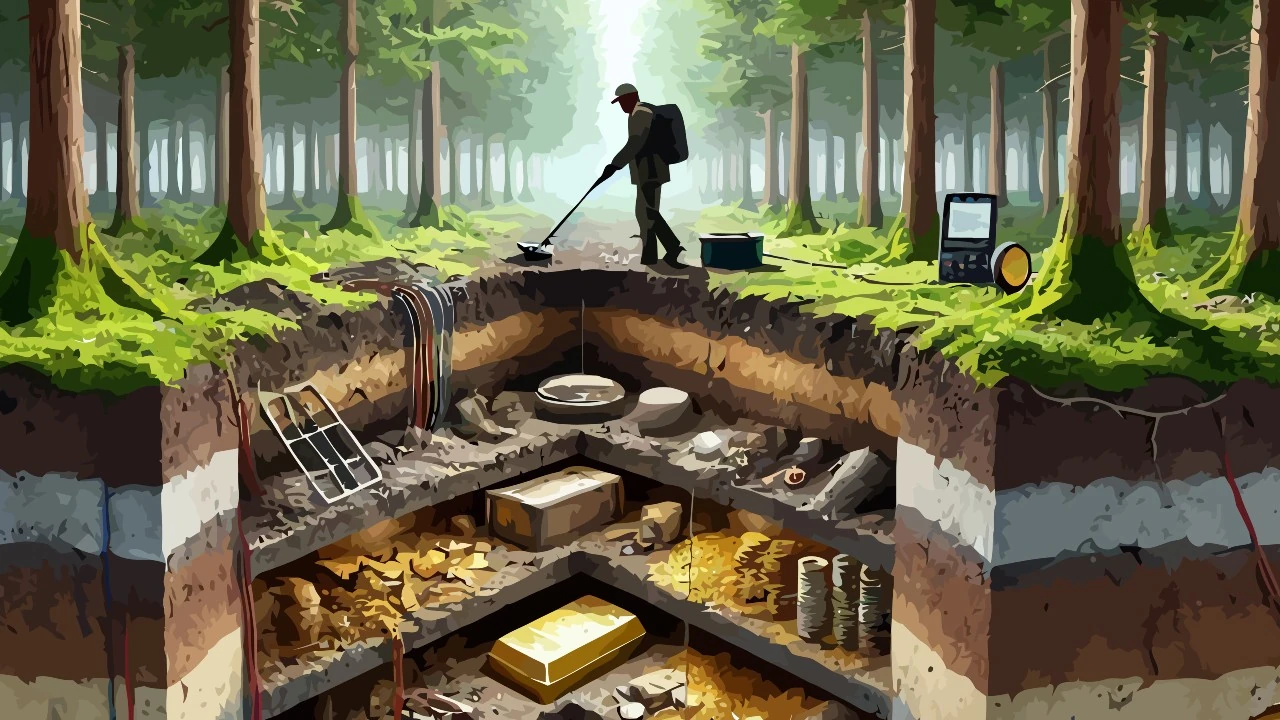Protecting gold and silver is an ancient practice, motivated by reasons of personal safety, asset protection and discretion. However, in a world where underground detection technologies are increasingly advanced, effectively hiding precious metals requires intelligent strategies and a thorough knowledge of existing techniques and devices.
In this article, we will explore the safest methods for hiding gold and silver, as well as the capabilities of metal detectors and underground detection tools.
Contents
#1. Choosing the ideal location
Choosing the ideal location to hide gold and silver is the first crucial step. This decision must take into account several factors: safety, the possibility of long-term recovery and the ability to elude any future searches. It is important to carefully evaluate the surrounding environment, the type of soil and human activities that could affect the area.
- Natural Areas: Natural areas such as forests, mountains and isolated rural areas can be ideal choices for hiding precious metals. However, it is essential to avoid areas subject to natural phenomena such as erosion, landslides or flooding that could compromise the security of the cache. Areas with dense vegetation offer visual cover and reduce the likelihood of accidental discovery.
- Private property: Using private property, such as gardens or farmland, offers greater control over the location chosen. However, it is essential to consider the risks associated with future construction or agricultural work that could compromise the hiding place. In these cases, it is advisable to avoid easily accessible or visible areas and prefer less frequented areas.
- Urban Environments: In urban environments, hiding precious metals requires more sophisticated strategies. Basements, wall cavities, and raised floors can offer discreet solutions. However, it is essential to avoid obvious locations such as safes or secret drawers. Advanced camouflage techniques, such as creating false walls or hidden compartments, can increase security.
The choice of location must also be made taking into account the possibility of recovering gold or silver in the future, avoiding areas subject to structural or natural changes.perare l’oro o l’argento in futuro, evitando zone soggette a cambiamenti strutturali o naturali.
#2. Underground concealment techniques
Burying precious metals requires attention to detail to ensure that the cache remains intact and undetectable. Several factors influence the effectiveness of the cache, such as depth, soil type, and materials used.
- Recommended Depth: The depth at which you should bury metals varies depending on the size and weight of the object. Small quantities can be hidden at a depth of 1.5-2 meters, while larger quantities require greater depths, up to 5 meters or more, to elude the most powerful metal detectors.
- Soil Type: The ideal soil is firm and stable. Sandy or marshy soils tend to shift over time, making recovery difficult. Clay or rocky soils offer greater stability and reduce the likelihood of the concealment being compromised by natural events.
- Protective Containers: To protect metals from moisture and corrosion, it is essential to use waterproof and resistant containers, such as those made of rigid plastic or ceramic. Using clay bags or dry sand as internal filler can further insulate metals.
- Magnetic Shielding: Shielding techniques such as wrapping in multi-layered aluminum foil or using lead shells can attenuate magnetic signals detected by metal detectors. However, it is important to apply these shields correctly to maximize their effectiveness.
- Environmental Masking: After burial, it is crucial to restore the surrounding environment in a natural way. Planting vegetation or using natural debris helps to eliminate obvious signs of intervention. It is also useful to avoid regular or symmetrical patterns that could attract attention during possible searches.
The combination of these measures greatly increases the likelihood that your gold and silver will remain hidden and safe.
#3. Secure home hiding places
Inside homes, creating safe hiding places requires creativity and attention to detail. The goal is to create hidden spaces that are difficult to detect during standard searches or the use of metal detectors.
- Wall cavities: Creating hidden cavities or niches between walls is one of the most commonly used techniques. You can make removable panels or use hollow bricks to create small spaces. However, it is important to avoid areas where there are electrical or plumbing systems.
- Raised Floors and False Walls: Some homes have raised floors that allow items to be hidden in the space underneath. Alternatively, constructing false walls or ceilings can create hiding places that are difficult to find.
- Modified furniture: Furniture such as wardrobes, bookcases or tables can be modified to include hidden storage. For example, secret drawers or false bottoms can be installed. Even everyday objects such as lamps or paintings can be adapted to contain small amounts of metal.
- Unexpected spots: Using spaces that are generally overlooked can increase security. Empty cisterns, unused chimneys or ventilation ducts can serve as excellent hiding places.
The key to an effective home hiding place is discretion. Avoid overly obvious solutions and favor places that will not attract attention during possible searches.
#4. Anti-detection barriers
Anti-detection barriers are essential to increase the security of hiding places and reduce the possibility of discovery by detection tools.
- Wire Mesh and Screening: Installing wire mesh above or around the concealment point creates distorted signals that confuse metal detectors. These nets can be buried at varying depths to increase effectiveness.
- Layers of Insulating Materials: Using materials such as compacted clay or silica sand over the cloaking area helps shield electromagnetic signals. These materials reduce signal transmission and make detection more difficult.
- Shielded Containers: Lead or copper containers can attenuate the magnetic fields generated by precious metals. This technique is especially useful when hiding large objects.
- Decoys: Placing low-value metal objects over the concealment point can divert attention during a search. These “decoys” can fool detectorists into believing they have only detected insignificant metal fragments.
The effectiveness of barriers depends on their strategic placement and their ability to confuse or attenuate the signals detected by the instruments.
#5. Metal detectors and detection
Knowing the capabilities and limitations of detection tools is essential to planning effective concealment strategies. Metal detectors and underground detection technologies have evolved significantly over the past decades, allowing metal objects to be detected at greater depths and with greater accuracy. However, each device has specific characteristics that determine its effectiveness in certain contexts.
- VLF (Very Low Frequency) Metal Detectors: Low frequency metal detectors are the most common among hobbyists and are designed to detect small metal objects with good sensitivity at limited depths. These devices generally operate between 3 and 30 kHz and can detect coins or jewelry up to a depth of about 40 cm. However, they are affected by ground mineralization which can generate false signals. VLF is ideal for dry and slightly mineralized ground.
- PI (Pulse Induction) Metal Detectors: Pulse induction metal detectors are less sensitive to ground mineralization and are therefore used in difficult environments such as beaches or clay soils. These devices send electrical pulses into the ground and detect anomalies created by buried metals. They can detect medium to large objects up to depths of 3-5 meters, but are less accurate with very small objects. PIs are preferred for deep searches in complex terrain.
- GPR (Ground Penetrating Radar): the georadar is a professional instrument that uses radar waves to detect anomalies in the subsoil. It can penetrate up to 10 meters deep, depending on the frequency used and the type of soil. GPRs are particularly useful for detecting underground cavities, ducts and large metal objects. However, the high cost and the need for expert operators limit their use to professional fields such as archaeology and geology.
- 3D scanners and tomography: these advanced tools allow the creation of three-dimensional models of the subsoil, allowing the analysis of stratifications and the identification of buried objects. Mainly used in the archaeological or mining fields, 3D scanners offer high precision but require time and resources for data processing.
#6. Safe depth and evasion
Determining the proper depth and most effective strategies for hiding gold and silver is essential to ensuring the long-term safety of the cache. Variables to consider include the mass and volume of the metal, the composition of the soil, the detection techniques potentially used, and environmental conditions that could affect the cache over time. A strategic approach that considers these factors significantly increases the likelihood that the cache will remain hidden and secure.
- Small objects (<250g): Coins, small bars or jewellery require a minimum depth of 1.5-2 metres. This depth is more than sufficient to elude VLF (Very Low Frequency) metal detectors, which typically reach depths of 30-40cm, and reduce the likelihood of accidental detection. However, the use of magnetic barriers or additional shielding can further increase security.
- Medium Objects (250g – 1kg): Standard bars or small coin collections must be hidden at a depth of at least 3 meters. This depth reduces the effectiveness of PI (Pulse Induction) metal detectors, which can reach 3-5 meters, especially in low mineralized soils. The integration of shielding barriers is essential for objects in this category.
- Large objects (>1 kg): Large deposits or heavy ingots require depths greater than 5 meters. In these cases, the use of magnetic shielding and multi-layer barriers is highly recommended to also reduce the risk of detection by GPR (Ground Penetrating Radar), which can reach depths of up to 10 meters.
Influence of soil type
- Clay and compact soils: provide a natural barrier to electromagnetic signals and reduce the penetration of radar waves.
- Sandy or porous soils: allow greater penetration of radar waves, making deeper concealment or the use of shielding necessary.
- Highly mineralized soils: These can mask metal signals and confuse metal detectors, providing natural protection.
Influence of environmental factors
- Soil Moisture: Wet soils improve electrical conductivity, increasing the detection depth for metal detectors. However, moisture can also accelerate corrosion of poorly sealed containers.
- Extreme temperatures: Freeze-thaw cycles can shift buried objects or alter the composition of the soil. It is essential to use sturdy containers and consolidate the hiding point.
- Land Movement: Landslides, landslides, or seismic activity can expose or move the deposit. Avoiding geologically unstable areas is crucial.
#7. Advanced concealment techniques
To effectively hide gold and silver and elude metal detectors, scanners and underground radar (GPR), it is essential to adopt strategies that reduce or distort the electromagnetic signals emitted by the detection devices. Here is a complete and grouped list of the most effective techniques:
Magnetic and Electromagnetic Shielding
- Lead or Copper Sheets: Create a barrier that absorbs and deflects signals emitted by metal detectors and underground radar (GPR), reducing the probability of detection.
- Faraday cage: Surrounding the vault with a closed metal mesh isolates the contents from electromagnetic fields, preventing detectors from picking up signals.
- Multilayer Aluminum: The use of overlapping sheets of aluminum reflects electromagnetic waves, attenuating the signals picked up by VLF (Very Low Frequency) metal detectors.
Natural and Artificial Barriers
- Highly Mineralized Grounds: Exploiting ground rich in iron minerals that create interference in metal detector signals, making it difficult to distinguish between metal waste and precious metals.
- Clay or Silica Sand Layers: Low-conductivity materials that absorb radar waves, reducing the penetration depth of GPRs and blurring the image of the subsurface.
- Ferrous Metal Overlay: Placing layers of common metals such as iron or steel over the deposit which create noise signals and mask the presence of gold and silver.
- Rocks and Natural Debris: Supplement the cache with geological features that refract or absorb radar signals, complicating underground mapping.
Creating False Positives and Metal Decoys
- Metal Decoys: Place small metal objects of little value (nails, cans, bolts) above the cache to create false signals and divert searches.
- Metal Waste Simulation: Create areas full of low-value metal waste to cause prospectors to overlook the site as uninteresting.
- Dummy Hiding Places: Place low-value items in easily detectable hiding places to distract and mislead potential searchers.
Strategic Depth and Irregular Layout
- Deep Burial: Burying gold and silver at depths beyond the standard detection limits of metal detectors (over 5 meters) and GPRs (over 10 meters) to reduce the probability of detection.
- Irregular Arrangement: Avoiding predictable linear or geometric patterns by arranging objects in an irregular fashion to confuse the interpretation of signals.
- Use of Artificial Cavities: creating underground voids around the repository that refract radar waves and generate complex and difficult-to-interpret signals.
Alteration of Electromagnetic Properties
- Absorbent Paints and Coatings: Use carbon or graphene-based coatings that absorb electromagnetic waves, reducing signal reflection.
- Blending with Non-Conductive Materials: Supplement the depot with materials such as glass, ceramic or plastic that decrease the electromagnetic signature perceived by the devices.
Environmental Manipulation
- Vegetation Planting: The roots of trees and plants create natural anomalies that distort radar signals and hide any artificial variations in the terrain.
- Natural Barriers: Use geological features such as boulders or logs that deflect signals and hide underground anomalies.
Technological Deception
- Jammers: Emit electromagnetic signals that interfere with the operation of metal detectors and scanners, rendering them ineffective.
- Magnetic Noise Generation: Install interference sources near the deposit to generate background noise that mask detectable signals.
- High Natural Interference Areas: Hide the treasure in areas with strong natural or man-made electromagnetic interference (near underground power lines or industrial areas).









Leave a Reply